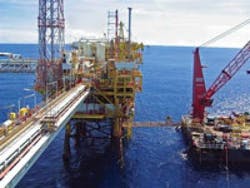Method provides welders new technique for avoiding arc blow
A new method allows welders with little background in magnetism to reduce arc blow during DC welding of pipelines.
Arc blow most commonly occurs after an in-line magnetic-flux-leakage inspection tool magnetizes a pipe wall during an inspection run. DC arc welding is one of the most popular techniques in the oil and gas industry because of its versatility and relatively low cost. Interaction between the magnetic field associated with the current flowing through the electrode and the residual magnetic field in the pipeline under repair can produce arc blow.
This article describes a simple method to reduce arc blow during DC arc welding of pipelines. In contrast to methods so far available in the literature,1 2 the method proposed here provides simple rules for welders with little background in magnetism.
Technicians measured residual magnetic field levels of different pipelines in southern Mexico in the gap following girth-cut of damaged sections and in the V-groove following insertion of the new sections. FEMM3 performed magnetic finite element simulations for residual magnetic field compensation using real-life pipeline dimensions and field parameters. Simulations used variables such as residual magnetic field in the groove, number of coil turns required for the residual magnetic field compensation, DC current flowing through the coil and the electrode, position of the coil relative to the groove, and pipeline WT and OD. Results allowed development of an empirical predictive equation for the magnetic field required to compensate for the residual magnetic field in the weld groove.
Most of the procedures developed in the past adjusted current in order to compensate for the magnetic field in the groove, a disadvantage during DC arc welding since the electrodes' specifications do not cover a wide range of current values. The method proposed here supersedes this disadvantage by making it possible to properly select the number of coil turns and the position of the coil relative to the groove to compensate for residual magnetic field in the groove.
Arc blow
Residual magnetization of the parts to be soldered often affects DC arc welding of pipelines during repair causing the arc to deviate, a phenomenon known as arc blow. Steel pipelines are huge ferromagnetic structures and can be magnetized by the earth's magnetic field if they extend from north to south. Arc blow becomes a concern when a pipeline has been subject to a strong magnetic field. MFL in-line inspection tools ("pigs") can induce residual magnetization in operating pipelines. MFL pigs use strong permanent magnets to saturate the pipe wall magnetically.
DC arc welding is a manual process establishing an electric circuit between the welding power supply, the electrode, the welding arc, the parts to be soldered, and the ground connection. The current flowing through a conductor produces a magnetic field according to Ampere's law. The interaction between this magnetic field and the residual magnetic field of the parts causes a displacement of the arc relative to the joint. The continuing displacement of the arc can cause weld defects.
Arc blow depends on the direction and magnitude of the residual magnetic field of the parts. The magnitude of the residual magnetic field in the welding zone should measure less than 30 Gauss to ensure a high-quality weld.4 Measuring the magnitude and polarity of the residual magnetic field in the groove with a gaussmeter is mandatory. Once the magnitude and polarity of the residual magnetic field are known, a coil wrapped around the pipeline close to the groove reduces its residual magnetic field.
Fig. 1 schematically shows a V-groove and the three possible compensation scenarios. The ideal case occurs when the applied magnetic field (Ha) opposes the residual magnetic field (Hg) in the groove and the resultant magnetic field (Hr) is zero. In the second case, Ha is not high enough, resulting in an undercompensation with Hr = Hg – Ha. In the overcompensation case, Ha is strong enough to reverse the polarity of the resultant magnetic field. These last two cases create the risk of arc blow.
Kildishev et al. proposed a deperming technology for large ferromagnetic pipes based on compensating for the axial field in the groove by remagnetizing the pipe near the joint.2 The procedure is scientifically correct but assumes a solid background in magnetism.
Proctor proposed a practical and simple procedure for reducing the magnetic field at pipeline tie-ins, well known in the oil and gas industry,1 observing variation of current flowing through the coil-electrode to compensate for the residual magnetic field in the groove. Required current magnitude changes, however, could lie outside the range of current valid values specified for the electrode in DC arc welding procedures. Proctor's procedure requires, as a general rule, wrapping the welding ground lead with four to six-turns coil at about one-half OD from the groove and modifying the electrode current to compensate for the residual magnetic field in the groove.
The American Welding Society classifies welding electrodes according to size (in.) and current range (amp). An E6010 electrode of 1⁄8 in., for instance, has a current range of 75-130 amp. Galvery and Marlow recommend the use of the lower current to obtain a smooth arc.4 Welders adjust the current through the electrode at the beginning of the welding procedure to obtain a correct arc length and good stability but cannot guarantee a proper compensation of the residual magnetic field in the groove with the variation of the electrode current when the number of turns and position of the coil from the groove are fixed.
Experimental investigation
Technicians took several measurements of the residual magnetic field of pipelines in southern Mexico (Fig. 2). A Magnet-Physik FH-51 Gaussmeter took magnetic flux density measurements of 8, 10, and 30-in. OD pipelines.6
Removed pipeline sections measured 34 m, 6.2 m, and 24.3 m. Table 1 shows the average values of the residual magnetic field in three different scenarios. Measurements occurred at four different points along the pipeline's circumference, starting at 12:00 and ending at 9:00 hr. These measurements took place:
Technicians took manual measurements at four different points along the pipeline's circumference, starting at 12:00 and ending at 9:00 hr. The residual magnetic field measurement shown is taking place in the gap created by cutting the pipeline (Fig. 2).
• In the gap after the pipeline was cut (MB in Table 1, Fig. 2).
• At the edge of the new section before its insertion between the pipeline segments (MC).
• In the welding groove after the new section was inserted and lined up with the other pipeline segments (MA).
The edges of the pipeline were roughly flat in the first two cases. The V groove had already machined according to API-1104 standard in the last instance.7
The average values marked as MA, underlined in Table 1, correspond to the values needing to be compensated for to avoid arc blow during welding. The pipelines with 10 and 30-in OD have values more than 10 times higher than the maximum permissible value of 30 Gauss needed to avoid arc blow.
Modeling, simulation
FEMM helped develop an axi-symmetric model of the pipeline with a coil of n-turns.3 FEMM is a freeware program for electrostatic and magnetic finite-element simulations in two dimensions. Fig. 3 represents the model used to simulate the residual magnetic field in the groove and the compensation process by selecting different current values flowing through the coil.
The simulation process used 16-m pipe sections with a groove consistent with dimensions dictated by API-1104.7 An Nd-Fe-B magnet in the form of a ring produced the residual magnetic field in the groove. Changing the coercivity (HC) of the Nd-Fe-B material produced the different values of the residual magnetic field.
The simulation used variables:
• t = WT.
• n = number of coil turns.
• I = soldering current flowing through the coil and the electrode.
• x0 = coil position relative to the groove.
• D = OD.
• Hg = residual magnetic field intensity in the groove.
Table 2 presents the variables of the simulation runs and their respective values. Considering all possible combinations yielded 3,584 simulation runs.
Results
FEMM simulation software estimated the values of the applied magnetic field necessary to compensate for the residual magnetic field levels in the groove, producing a total of 3,584 values of the resultant magnetic field, Hr. These values cover all possible stages during the compensation process: undercompensation, compensation, and overcompensation.
Fig. 4 shows examples of the relationship between Ha (proportional to nI) and the position of the coil relative to groove x0 for seven intensities of the residual magnetic field Hg on two pipelines of 0.5-in. WT and 10 and 24 in. OD.
Fig. 4 shows the applied magnetic field Ha required to compensate for the given residual magnetic field Hg in the groove as a function of the position of the coil x0. The amount of energy Ha (proportional to nI) to achieve compensation depends directly on the position of the coil relative to the groove, OD, and WT. Fig. 4 supports the assumption that the coil must be placed in the immediate vicinity of the groove to achieve compensation with a minimum amount of energy.
As a general rule, therefore, operators should wrap the coil as closely as possible to the groove. The coil position, however, will ultimately depend on the residual magnetic field being compensated for and the optimum current necessary to obtain the appropriate arc length for the given electrode.
Compensating for the residual magnetic field in the groove could be a complex task for operators without a clear and simple step-by-step procedure. Equation 1 is a general expression of the resultant magnetic field Hr as a function of the selected simulation variables obtained with the results of the 3,584 simulation runs performed with FEMM. Introducing the whole dataset into the SPSS multivariate statistical software allowed proposal of a mathematical function best fitting the data with the polynomial expression 1, obtaining a correlation coefficient R2 = 0.93.
Closer examination of Equation 1 explains the influence of each variable in the compensation process. The applied magnetic field Ha (nI) necessary for compensation is inversely proportional to WT (t) and OD (D) of the pipeline and directly proportional to the position of the coil x0.
Equation 1 reduces to a simple expression when real-life conditions are taken into account. The compensation procedure aims to apply a magnetic field (Ha) counteracting the residual magnetic field (Hg) to obtain a resultant magnetic field (Hr) below 30 G, including a best case of Hr = 0 (Fig. 1).
WT and OD are known fixed parameters for each particular case. Operators generally intend to optimize system performance by wrapping the coil as closely as possible to the groove. Bearing these parameters and intents in mind, Equation 1 turns into Equation 2, where A (Equation 3) is a constant dependent on actual field parameters. Equation 2 is a simple relationship between the residual magnetic field (Hg) in the groove and the amount of energy (nI) required to avoid arc blow.
Equation 2 yields graphs with sets of curves for the compensation of any value of the residual magnetic field in the groove. Fig. 5, for example, shows two sets of curves obtained for different pipeline WT, OD, and compensation coil position. Applying Equation 1 to all possible ranges of the variables considered in the model would yield a complete set of such graphs making graphs similar to those shown in Fig. 5 for different combinations of the field parameters (t, D, I) and variables (n, x0 ) available to operators and providing a straightforward tool for avoiding arc blow.
Proposed procedure
The first step of the welding process is to adjust the current through the electrode to obtain the optimum arc length. Electrode selection itself depends on many factors, including welder skill and base metal properties. The operator will always know in advance the range of current to be used for a specific welding task according to the electrode selection. Applying Equation 1 can reduce and optimize each case's compensation curves.
A step-by-step compensation procedure follows:
1. Measure the strength (magnitude) and polarity (direction) of the residual magnetic field in the groove with a gaussmeter.
2. With the magnitude of the residual magnetic field (Hg) known, and knowing the characteristics of the pipeline under repair, select the appropriate set of graphs. The position of the compensation coil is important during this selection. It should lay as close as possible to the groove. The value Hg allows the necessary Ampere-turns (nI) to be estimated with the proper compensation curve (Fig. 5).
3. Divide nI by the selected value of current I flowing through the electrode. This provides the number of coil turns.
4. Wrap the welding ground lead around the pipe, according to the selected parameters, in such a way as to produce a magnetic field opposing the residual magnetic field in the groove.
5. Put the gaussmeter probe inside the groove to verify compensation. The welder should use an extra work piece for welding and at the same time perform the magnetic measurement in the groove. This guarantees the electrical circuit is closed, maintaining operator safety.
6. If the residual magnetic field is compensated for (<30 G), remove the gaussmeter probe and start the welding process.
DC arc welding can use two different electric circuits according to electrode type: Direct Current Electrode Positive (DCEP) or Direct Current Electrode Negative (DCEN). Step 4 should be performed carefully to avoid delays and consequent reduction in productivity.
Fig. 6 can help operators set a circuit for compensation. It assumes a working electrode of DCEN type, meaning the DC power supply has a positive ground terminal. All gaussmeters give the polarity of the measured magnetic field, either sign or pole-type, based on the orientation of the measurement probe. If residual magnetic field Hg has the polarity shown by the red arrow line, the gaussmeter reading will be positive, or will mark a north pole. In this case, the coil should be wrapped as shown in Fig. 6 to produce a magnetic field Ha (marked with the blue arrow) counteracting the residual magnetic field.
With a DCEP electrode the DC power supply has a negative ground terminal. If the residual magnetic field has the same polarity as shown in Fig. 6 the coil should be wrapped in the opposite direction to achieve compensation.
References
1. Proctor, N.B., "The Removal of Detrimental Magnetic Fields at Pipeline Tie-Ins," Pipeline Research Council International, Catalog No. L51389e, Houston: Technical Toolboxes Inc., 1980.
2. Kildishev, A.N., Nyenhuis, J.A., Dobrodeyev, P.N., and Volokhov, S.A., "Deperming Technology in Large Ferromagnetic Magnetic Pipes," IEEE International Magnetics Conference, Kyongju, Korea, May 18-21, 1999.
3. Meeker, D., Finite Element Method Magnetics, Version 4.0, User Manual, http://femm.foster-miller.net/.
4. Bakunov, A.S., and Muzhitskii, V.F., "Testing Residual Magnetization of Parts before Welding," Russian Journal of Nondestructive Testing, Vol. 40, No. 3, pp. 209-210, March 2004.
5. Galvery, W.L., and Marlow, F.M., Welding Essentials: Questions & Answers, pp. 117, New York: Industrial Press Inc., 2000.
6. Operation instructions FH-51 Gauss-Teslameter, Magnet-Physik Dr. Steingroover GMBH, www.magnet-physik.com.
7. API Standard 1104, "Welding of pipelines and related facilities," 20th Ed., American Petroleum Institute, 2005.
The authors
Jose Hiram Espina Hernandez ([email protected]) is a professor at the Instituto Politecnico Nacional (IPN). He is a researcher at the Convenio de Investigacion y Desarrollo de Integridad Mecanica (CIDIM) of the IPN. He holds a BS in electrical engineering, an MS in automation, and a PhD in technical sciences from the Instituto Superior Politecnico Jose Antonio Echeverria of Havana.
Francisco Caleyo ([email protected]) is a professor at the IPN. He is a senior researcher at the CIDIM of the IPN. He holds a BS in physics and an MS in materials science from Universidad de La Habana and a PhD in materials science from Universidad Autonoma del Estado de Mexico.
Gabriela Lourdes Rueda Morales ([email protected]) is a professor at the IPN. She is researcher at the CIDIM of the IPN. She holds a BS, an MS, and a PhD in physics from IPN.
Jose Manuel Hallen ([email protected]) is a professor at the IPN and heads the CIDIM, which has service contracts with Pemex to conduct mechanical integrity and risk analyses of onshore and offshore pipelines. He holds a BS and MS in physical metallurgy from IPN and a PhD in physical metallurgy from the University of Montreal.
Abraham Lopez Montenegro ([email protected]) is a superintendent of pipeline reliability at the Gerencia de Transporte y Distribucion de Hidrocarburos, Pemex Exploracion y Produccion. He holds a BS in industrial chemistry engineering from IPN and an MS in project management engineering from the Universidad de las Americas, Mexico.
Eloy Perez Baruch ([email protected]) is maintenance vice-manager at the Gerencia de la Coordinacion Tecnica Operativa Region Sur, Pemex Exploracion y Produccion. He holds a BS in industrial chemistry engineering from IPN and an MS in pipeline management engineering from the Universidad de las Americas, Mexico.
More Oil & Gas Journal Current Issue Articles
More Oil & Gas Journal Archives Issue Articles
View Oil and Gas Articles on PennEnergy.com






